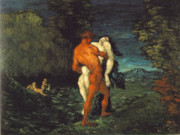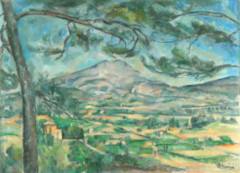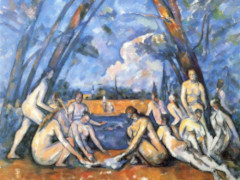The exhibition
I came across the exhibition rather by accident. I was on a day trip to the city of Alkmaar with two friends, and we stumbled upon the museum. The name Van Gogh drew us in. As much as I would like to pretend to be an art connaisseur, I am not the type to frequent museums. (I say so, but over the past years the opposite has proven to be the case).
It was inside that the plan became clear: draw the visitors in with Van Gogh written in font size a million, and then hit them in the face with Van Blaaderen. And bam… Paul Cézanne.
Some background
So Paul Cézanne was definitely talented. Here is one of his early works.

Objectively, we get little information from Cézanne. We see a man carrying a subconscious - or perhaps desperate - woman. They are seemingly from nowhere.
There is not as much as a hint as to what the landscape looks like on the left, outside the frame. On the right, we see where they may be heading, but that too is devoid of any detail.
We see two women relaxing nearby. Their lack of alarm is almost reassuring -- had the title of this painting been The Saviour
, we might imagine a hero carrying a fainted damsel to shade.
That is the next thing that we should immediately notice; the damsel
from that hypothesis would not seem so helpless, had she been conscious.
We see her formidable frame outmatch that of her captor. He cannot have conquered her in a fair fight (in fact, he seems to struggle to hold her).
The major theme that we identify moving through Cézanne's career is that of the human body. From ibiblio:
Cézanne's late studies of the human body are most rewarding, his figures often depicted as bathers merging with the landscape in a sunlit lightness.
…merging with the landscape in a sunlit lightness. Quite a shift from the early work we are seeing here.
Les pièces de résistance
We depart from the dark and sinister, and arrive in the scenery I came across at the exhibition. Cézanne has the most fantastic landscapes.
It's these types of works that moved me to write this little piece. Here we have Mont Saint-Victoire.

The blue and green join forces and provide a visual blanket over top of this painting, the branches draped across the silhouette of the mountain. The top half of this piece reminds me of my stay at Mt. Fuji. The lower half is the long drives through Tuscany. Together it is a triumph.
We don't see any bathers in this work, however.
This work, amply named The Bathers from 1906, shows what the artist's earlier works were the setup for.
Dominating the view is a group of bathers, huddeled together en masse in a diagonal frame.
This is a common trait shared by many of the bathers Cézanne immortalized. They guide our eyes towards the bath and the sky.

The sky also plays a big role in the filling of the canvas. Where other paintings he did on the subject used foliage and bold green strokes to fill the height of the painting, here Cézanne thickens the air itself.
And again, this sky lightens towards the center, creating a push to look past the obvious bathers and evokes curiosity about the people at the other shore:
We know these bathers, sure. But what about them? Who are they? And why are they so seperated from the rest -- not only visually, but also physically by a large body of water?
Conclusion
Well, I'm no art critic and I don't think I will ever become one. But I do find beauty in such works. Not only paintings, but also music and literature.
I'm afraid I may find myself in the habit of collecting before I am thirty. Not Cézanne; perhaps something a little more modest. Art can be a good investment and I believe a real joy to own. But that is big money talk.